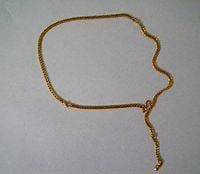 | ||
Aranjanam or Araijan Kayiru(Malayalam: അരഞ്ഞാണം Tamil:அரைஞான் கயிறு) is a girdle like ornament tie around the waist of infants and children. Also called 'Araijan Kodi'. It is made up of gold, silver or thick thread. The important and main purpose is to know the healthy growth of an infant on those days also to hold the cloth on the waist, a belief that it get rid of evil spirits. Although in India, most women and many men continue to wear them as adults as well.
Ancient Tamil people used it, mentioned in Tolkappiyam, Sangam literature describes the usage of Araijan by the words வெண்ஞான் (Venjan - made of silver) and பொன்ஞான் (Ponjan - made of gold). A village in Tamil Nadu was named after it called 'Venjan Kondaan' meaning one who wore Silver Araijan.
Thin ornamental gold or silver chain worn around the midriff, under clothing. In India, it is worn by many women and men, and most children and babies.
An Aranjanam is given to babies of both genders and all religious affiliations, particularly in south India, on the 28th day after the baby's birth, as part of a ceremony called Irupathettu in which the baby is given its name, its first jewellery, eye makeup and a meal of sweet porridge.
Aranjanam Kettal
In Kerala, This ceremony is performed on the 28th day after birth of the child, as this is the first time the nakshatram (star) of the child repeats according to the Malayalam calendar. During the ceremony, charadu (thread), one in black cotton and the other a chain in gold are intertwined and tied around the waist of the child - this is usually done by the father of the child. This thread is called 'Aranjanam'. The child's eyes are lined with mayye or kanmashi (Kohl). A black spot is placed on one cheek or asymmetrically on the forehead, to ward off the evil eyes. The father whispers the chosen Hindu name in the child's right ear three times while the left ear is covered with a betel leaf. This is then repeated with the left ear. A mixture of ghee (melted and clarified butter) and honey is given to the infant as a base for its various foods in the future.
